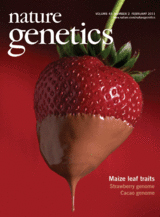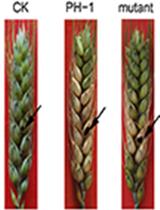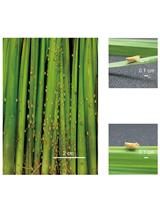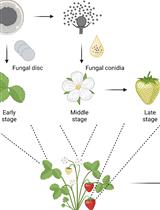- EN - English
- CN - 中文
Large Scale Field Inoculation and Scoring of Maize Southern Leaf Blight and Other Maize Foliar Fungal Diseases
玉米南方叶斑病及其他叶片真菌病的大面积野外接种与评分
发布: 2018年03月05日第8卷第5期 DOI: 10.21769/BioProtoc.2745 浏览次数: 9171
评审: Zhibing LaiGuan-Feng WangAnonymous reviewer(s)
Abstract
Field-grown maize is inoculated with Cochliobolus heterostrophus, causal agent of southern leaf blight disease, by dropping sorghum grains infested with the fungus into the whorl of each maize plant at an early stage of growth. The initial lesions produce secondary inoculum that is dispersed by wind and rain, causing multiple cycles of infection that assures a high uniform disease pressure over the entire field by the time of disease scoring, which occurs after anthesis. This method, with slight modifications, can also be used to study the maize fungal diseases northern leaf blight (caused by Exserohilum turcicum) and gray leaf spot (Cercospora zeae-maydis).
Keywords: Maize (玉米)Background
Southern leaf blight (SLB), caused by Cochliobolus heterostrophus (Drechs.) Drechs. [anamorph = Bipolaris maydis (Nisikado) Shoemaker], is a widespread maize disease which causes significant yield losses in hot, humid tropical and sub-tropical regions, such as the southeastern USA, parts of India, Africa, Latin America and Southern Europe. In 1970-71 an SLB epidemic caused by C. heterostrophus race T infecting hybrids carrying Texas male-sterile cytoplasm (cms-T) caused an estimated 15% loss in total maize production in the US (Ullstrup, 1972). After the 1970 epidemic, cms-T maize was replaced by race T-resistant, normal cytoplasm maize.
Currently, race O is the predominant cause of SLB in the US and worldwide (Wang et al., 2017). SLB resistance to C. heterostrophus race O is quantitatively inherited with primarily additive or partially dominant gene action (Holley and Goodman, 1989). Under experimental conditions, yield losses due to infection with C. heterostrophus race O as high as 46% have been observed (Fisher et al., 1976; Byrnes and Pataky, 1989). However, losses in commercial production are generally much less severe (Mueller et al., 2016).
This approach to inoculation and rating is based on methodology developed by Carson et al. (2004), though similar methods had been used in numerous previous studies (e.g., Fisher et al., 1976). We have used it in a number of studies to screen germplasm for SLB resistance and to elucidate its genetic basis (Balint-Kurti et al., 2006; 2007 and 2008b; Zwonitzer et al., 2009 and 2010; Kump et al., 2011; Negeri et al., 2011; Belcher et al., 2012; Santa-Cruz et al., 2014; Yang et al., 2017). We have also used an essentially identical method to assess resistance to two other foliar fungal diseases; Gray leaf spot caused by Cercospora zeae-maydis (e.g., Balint-Kurti et al., 2008a) and northern leaf blight (NLB) caused by Exserohilum turcicum (e.g., Balint-Kurti et al., 2010; Chung et al., 2010; Zwonitzer et al., 2010). This method has provided reliable data with high correlations between replications and environments.
Materials and Reagents
- Petri dishes, 100 x 15 mm (Genesee Scientific, catalog number: 32-107G )
- Micro-spatula (VWR, catalog number: 82027-518 )
- Parafilm M (Bemis, catalog number: PM999 )
- 50-ml conical tubes (Corning, Falcon®, catalog number: 352070 )
- 15-ml sterile tube
- Garbage bag large enough to line cooler
- Newspapers
- Gloves
- Identi-plug foam plugs (Jaece Industries, catalog number: L800-E )
- Aluminum foil
- Small metal beads (Ballistic Products, #4 shot SHZ04 or similar)
- Isolates of Cochliobolus heterostrophus frozen in 50% glycerol
- Sorghum grain (wheat or barley may also be used)
Note: The sorghum should not be treated with any chemicals or fungicides. Sorghum intended for birdseed, also called milo, is ideal. - Difco Potato Dextrose Agar (PDA) media (BD, DifcoTM, catalog number: 213400 )
- A small quantity of 70% ethanol in a glass container with a lid
- Tween-20
- V8 juice
- Agar
- CaCO3
- V8-agar medium (see Recipes)
Equipment
- Laminar flow workbench (NuAire, model: AireGardTM ES NU-301 , catalog number: 301-630)
- Incubator (Percival Scientific, model: I-35LL )
- Tongs or large tweezers
- Scalpel (EISCO, catalog number: BIO182A )
- 1 L Erlenmeyer flasks (Corning, PYREX®, catalog number: 5100-1L )
- Autoclave
- Alcohol lamp (such as C&A Scientific, catalog number: 97-5313 ) filled with ethanol
- Plastic buckets
- Ventilated trays (Buckhorn, catalog number: BT28220522 )
- Oscillating fan (Air King, catalog number: 9119 )
- Cooler
- Pails
Procedure
文章信息
版权信息
© 2018 The Authors; exclusive licensee Bio-protocol LLC.
如何引用
Sermons, S. M. and Balint-Kurti, P. J. (2018). Large Scale Field Inoculation and Scoring of Maize Southern Leaf Blight and Other Maize Foliar Fungal Diseases. Bio-protocol 8(5): e2745. DOI: 10.21769/BioProtoc.2745.
分类
植物科学 > 植物免疫 > 病害生物测定
您对这篇实验方法有问题吗?
在此处发布您的问题,我们将邀请本文作者来回答。同时,我们会将您的问题发布到Bio-protocol Exchange,以便寻求社区成员的帮助。
Share
Bluesky
X
Copy link














